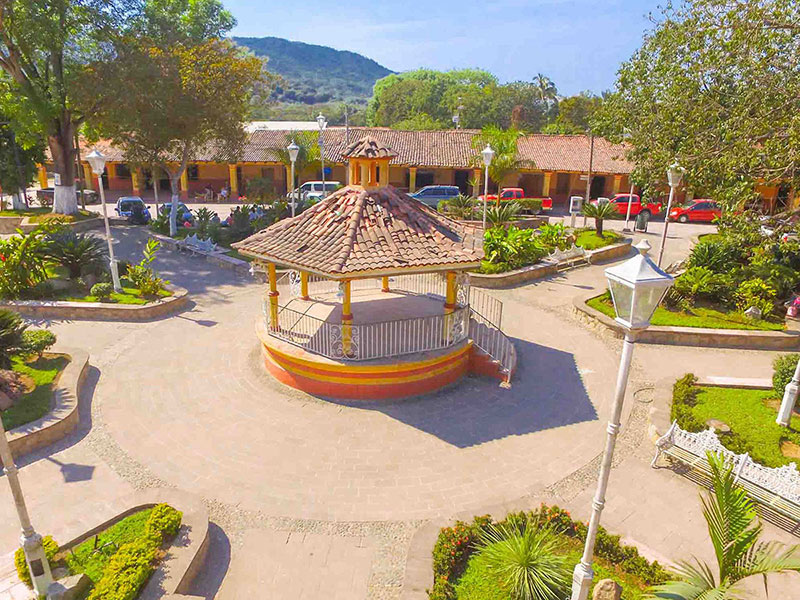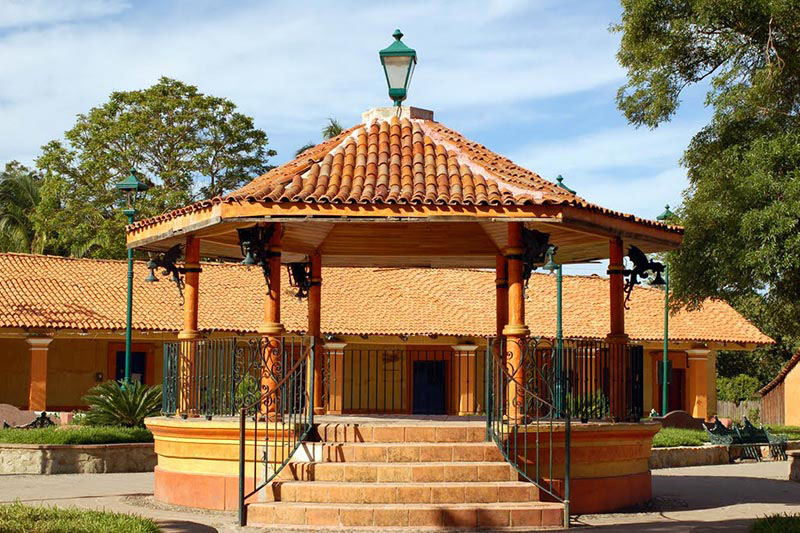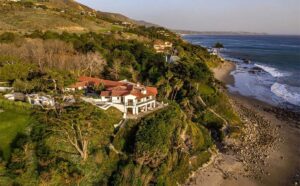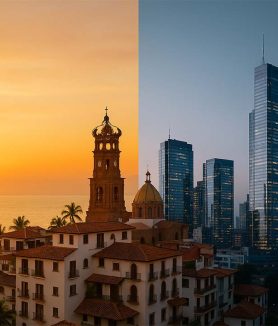By Rosa María Chávez Dagostino, Edmundo Andrade Romo and Rafael Torres
El Tuito, today the municipal seat of Cabo Corrientes, lived its bonanza thanks to sugar cane and its sweet products. Ranches with more than a thousand head of cattle, vast sugar cane fields, coconut oil palm groves on the coast, a self-sufficient and productive society, this is how El Tuito was between 1876 and 1938, when the lands that extend from the limit of what is now the urban sprawl up to the rocks of Los Arcos, back in Puerto Vallarta, were owned by a single owner. Of that splendor, only the ruins of the Hacienda El Tuito and its trapiche remain, in which they made piloncillo, sugar and brandy; you can barely see the foundations of the adobe walls that contained it, a few meters from an indigenous petroglyph, which shows a Patholli game.
There are no documents, no deeds; The history of the successful sugar company has been almost completely lost, except for the testimony of Mr. Roberto Ávalos Castillón (1921-2001), who is jealously keep in a video guarded by the Regional Analysis and Tourism academic body of the Center University of the Coast of the University of Guadalajara. The information, recorded in 1998, had not been transcribed until now.
Hacienda El Tuito was founded in 1876 by two families who came from Guadalajara. The De la Madrids and the Michels first searched for suitable land to establish a sugar mill. "I perfectly remember how it was processed and how the slopes came up to where the ovens and boilers were to stoke the boilers with firewood, that's why I think they did a good study of the land," recalls Don Roberto, who was municipal president of Cabo Corrientes between 1971 and 1973.
Once the place was chosen, they gathered workers and populated the community. They built the hacienda and on one side the mill, where the cane was processed. The land they acquired for the proper functioning of their industry was vast. "The entire area, from where the ruins of the hacienda are to the place where the Hacienda and La Nogalera rivers meet, were reedbeds. The land, however, reached as far as Los Arcos in Puerto Vallarta, there are landmarks, it extended along the coast to Quimixto and then towards the mountains, up to a very important point that is Yelapatapa", he explains.
The sugarcane harvest is seasonal, which is why the greatest activity on the farm occurred at the beginning of the year. The grinding began punctually every January 2 and did not end until the harvest ended, which generally happened during the month of April. "The grinding was done in a very rustic way, it was a wheel with a diameter of about six meters with an axis of walnut wood and its crosspieces towards the axis, with a drawer on top, because it was propelled with a fall of the drop was about three meters, that allowed the wheel to turn at a good speed. Then there were three pieces of solid iron, in the middle of which the cane was inserted to crush it and squeeze it. Four, eight, up to ten could be inserted reeds and absorbed everything", says don Roberto.
But if the Hacienda soon managed to become productive and provide livelihoods for more than 60 families, the owners encountered other problems. "The Indians of that time threw them out, they had to flee, if they did not leave they would be killed. This was already around 1900. During this process the landowners had Nabor Estrada as their steward, a native of Ixtlahuehuey but a resident of Las Guásimas. It was an honest and hard-working man. As they fled, there was no choice but to entrust the capital in its entirety to Don Nabor," he says. From the perspective of Ávalos Castillón, the De la Madrid and the Michels were not wrong when ceding their capital to Estrada, since he was an upright and tough man, much more suited to the life of the place who was able to keep the hacienda working and ended up paying them cent by cent all that he had received.
Upon the death of Don Nabor, his widow, Epifanía Peña places the operation of the hacienda in the hands of one of his workers, Alfonso García, who was the senior clerk of the store and perfectly understood the marketing of the mill's products. "He only knew about the store, neither about the land nor about anything else, but he was the most capable. García continued for a little while in the store, which was where today is the billiards. But when Mrs. Epifanía ceased to exist, she bequeathed the entire capital to some gentlemen Robles, Enrique, Teódulo and Epifanio, her nephews. All the capital that had belonged to Nabor Estrada ended up in the hands of Alfonso García, who bought everything from Doña Epifanía's relatives in installments", says Don Roberto. The former municipal president recounts that García was a good boss, who helped people and was concerned that the farm was productive. So much so that under his tutelage El Tuito became a community self-sufficient unit, which not only did not need to bring things from outside but also supplied the entire region with sugar and piloncillo.
In 1938 came the agrarian reform, promulgated by Don Lázaro Cárdenas, the creation of the common land of El Tuito and the distribution of García's lands. "The little truth that this one gave us all in the tower. Here is one of the towns where the agrarian distribution wiped out the population. Despite the fact that Alfonso told the ejidatarios: 'Gentlemen, I will buy the cane for you or I will I'll put them together, but don't let this industry be lost.' Instead, they opted to plant only corn and beans, until the farm began to fall apart, because money was needed to sustain it," concludes Don Roberto regretfully.
Livelihood
Palm trees have been more than just part of the landscape on the Mexican coast, a source of food, work, shade and even habitation.
It is a huge ship, almost as big as those that came to the Ixtapa area to collect bananas from Montgomery, but it approaches the bay at a point located much further south, at Cabo Corrientes. Their arrival announces to the town of Pisota the proximity of their festivities, with dancing, fairs and even a circus that also arrives at the hamlet by sea. But for the revelry to arrive, exchange is necessary. The men aboard the ship look for the coconut oil that the locals harvest, in exchange for a few pesos that by 1940 have managed to bring together 60 families in the town.
Palm trees seem to have been on the world's coastal landscape forever, they haven't. If the coast of Bahía de Banderas had its bonanza with coquito de aceite, or that of Colima is still sustained by the production of coco de agua, even if the town of Las Palmas, a little further from Ixtapa, was named thanks to the abundance of Palma Real that surrounded it, is once again the Nao from China an important part of history.
Just as the Spanish galleon brought Mexican vanilla to the Asian continent, it brought palm trees to the New Continent, plants with a single trunk that develop a tuft of leaves at the expense of a single terminal bud. Its exotic beauty attracted the attention of the sailors, as did its fruits, some large and filled with sweet water and others small from which an oily pulp could be extracted.
The nature of the palm trees turned out to be appropriate to the climate of America, so much so that only the seeds that escaped from the Nao were enough for the Pacific coast to be populated by different species in a few years. It soon spread, almost like a plague, throughout the territory and it is actually a family that adapts to practically any type of environment. Although they are in their best state in places with temperatures between 18 and 30 degrees Celsius, they can also bear more cold, although their growth slows down. They also easily adapt to different types of soil and although environmental humidity above 60 percent is essential for their good health, they can resist several weeks if it remains close to 30 percent.
Mrs. Eloisa Andrade remembers with nostalgia that time when she collected the coquito de aceite, when money circulated in Pisota. And it is that after the purchase and sale came the festivities. "Uh !, some dances that were done, almost just to hit a slap. How beautiful it was, there were cockfights, clothing stores, even the circus came," she says.
The palm tree is not only a species that defines the landscape of the Mexican beaches, it has also been a form of sustenance and food. In Colima and Guerrero, coconut water and its derivatives are still traded: cooked, oil, bleached and even glycerin. "First we break it, we take out the pulp and grind it with the nixtamal to make some toasts, or we put it to make atole, that is the famous koala," says the old woman. However, in the area surrounding Puerto Vallarta, the coquito de aceite stopped providing its delicacies.
For coconuts, in Colima
The coconut tree, or coconut palm (Cocos nucífera), is a single species with multiple varieties, basically differentiated by the color of the fruit (yellow or green). The plants only present differences in the stem. The common feature of all of them is the flavor of the fruit, whose characteristics are that it is pleasant, sweet, meaty and juicy. Its economic importance has made it begin to be cultivated on tropical beaches, its ideal place.

The flowers of the coconut tree are polygamomonoecious, with the male and female flowers in the same inflorescence. Flowering occurs continuously, with the female flowers producing the seeds or coconuts. As the coconut is a very resistant seed, it is spread over great distances by sea currents, getting to see coconuts floating on the coast of the Norwegian Sea and even with the possibility of being germinated later in suitable places.
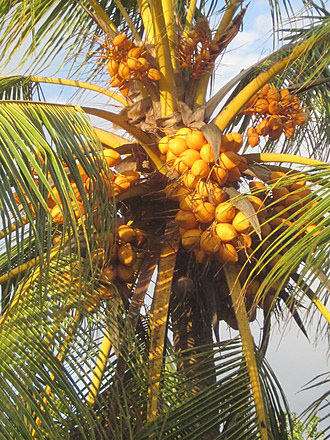
The coconut palm is among the oldest useful plants and is exploited in multiple ways. The dried pulp is called copra and contains 60-70% lipids; oil is obtained from copra, used in the production of margarine and soap. The wood of the coconut tree is used for construction. The inhabitants of Polynesia, Kiribati and the Marshall Islands consume the sap of the coconut tree fresh; fermented, it can be preserved and turned into a kind of alcohol, called toddy in English.
The fibers surrounding the coconut fruit are used to make brushes, mattresses, and ropes. In the Caribbean islands, it is customary to open unripe coconuts with a machete to extract the water from the fruit that is a refreshing drink. The internal water can remain up to eight months in the closed fruit and preserve all its qualities. According to what was published by Juan Carlos Reyes Garza, the coconut palm arrived in Colima towards the end of 1560, and it soon began to be cultivated and commercially exploited. One of the products derived from the fruit was a brandy that for some years competed with Iberian wines, for which reason its production was prohibited. Today, Colima is one of the main coconut producers in America.
Oil and good shade

The oil coquito palm, also known as guacoyul, (Orbignya guacuyul), is very similar to the coconut palm, it also reaches up to 30 meters in height, but its leaves are much longer, some exceed five meters, which is why it is the chosen one. when it comes to building a palapa. This species can be found discontinuously along the Pacific coast, from Nayarit to Oaxaca, grouping in very dense palm groves. Its fruits are ovoid nuts up to 6 centimeters long, yellowish in color and very fibrous, which under a very
greasy hide from one to three seeds.
But the coquito de aceite palm tree provides much more than good shade. For more than 50 years, the bankruptcy of coquito de aceite was the preponderant activity in the region. People waited for the coconut to dry out and then crack, so they could sell the coquito to companies that made soap, sunscreen, or cooking oil.
To dazzle
The royal palm (Roystonea regia) is also found in the region surrounding Puerto Vallarta, it is a species whose leaves stand out for their particular beauty. If Cubans boast that such a beautiful ornamental plant gives character to their fields, in Puerto Vallarta it can be presumed that its abundance gave its name to one of the nearby towns, Las Palmas. It reaches a height of 16 meters and its trunk does not have as many bumps as the rest of the palm trees. It grows in flat and mountainous terrain, preferably in fertile soil and humid places, such as river courses, swamp edges, streams and ravines. It is not found in savannahs or in soils derived from sulfated limestone. It also exists in Florida, Santo Domingo and Haiti; and it is cultivated in many countries (Roig, 1974).
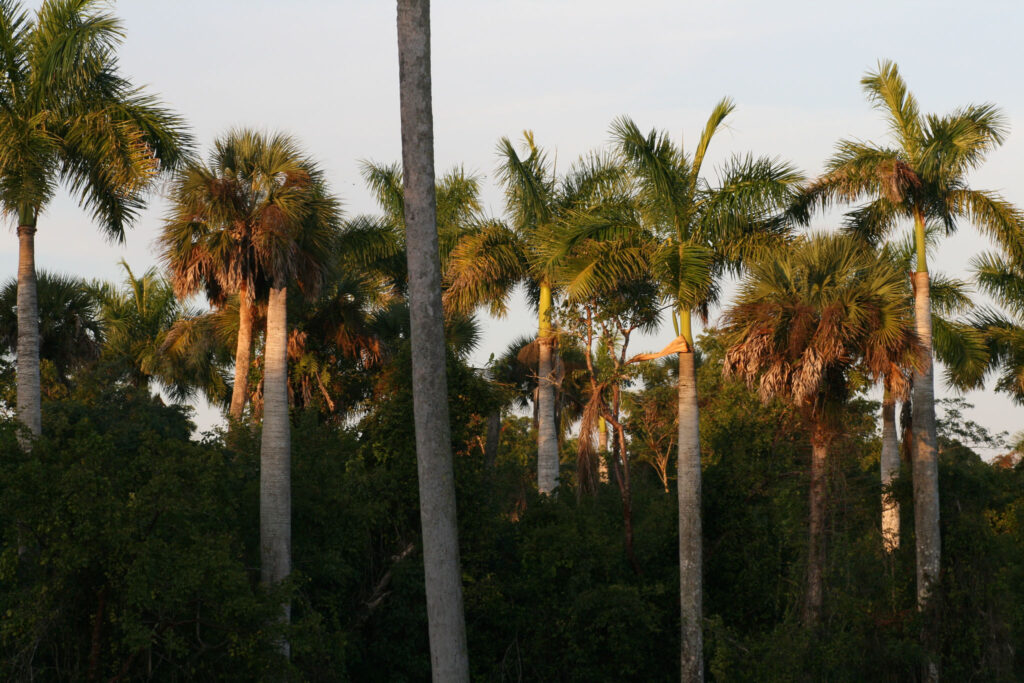
The royal palm can be found for its slender appearance, adorning parks, highways and avenues in the cities, but it is a very useful plant; it has emollient properties; Its root is diuretic and is used to expel kidney stones and diabetes, arteriosclerosis, cramps, asthma, colds, circulation, bleeding, leprosy, malaria and sprains. In Puerto Rico they also use it for stomach diseases and wounds. The wood is used in the construction of rural houses, decking, canes and containers for agricultural products; It presents special value for the beekeeper (Ordext, 1952), since its flowers are highly visited by bees. The fruit, the top and the "heart" are eaten by some people in the form of salad and in stews; also in several countries, when the head of the palm is cut, certain beetle larvae develop in the cavity that remains, which when toasted they constitute an exquisite morsel.
In 1944 the municipality of Cabo Corrientes was created and El Tuito became its municipal seat, despite the mill and the farm disappearing. Currently its main activity is agriculture; To the sowing of corn, beans, watermelon, chilte and the collection of coquito de aceite, adventure tourism has been added. Although the good times have ended, the magic in the town remains.
